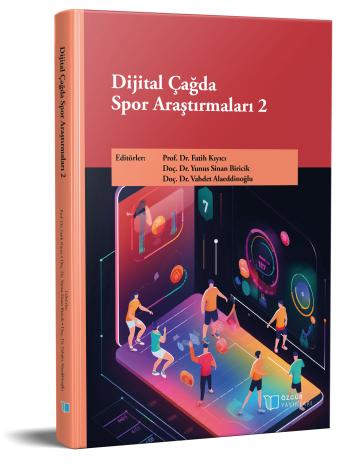
Dijital Çağda Spor Araştırmaları II
İndir
Özet
Değerli okuyucularımız, bugün sizlere "Dijital Teknoloji ve Spor İlişkileri" konusunu ele aldığımız bir kitapla karşınızdayız. Günümüzde dijital teknolojinin spor alanlarının etkileri oldukça önemli ve çeşitlidir. Bu kitapta, dijital teknolojinin sporun bütün alanlarında nasıl karşımıza çıkacak olan birbirinden değerli başlıklar ve içeriklere teknolojiyle nasıl bütünleştiği sunmuş olacağız. Okuyucusuyla buluşturduğumuz bu kitap bilimsel kaygılarla ve literatürün özgün kaynaklarıyla oluşturuldu. Kitabımızın açılış bölümü yapay zeka aracılığıyla oluşturuldu. Bu gelecekte biz bilim adamlarının başvuru kaynaklarının ne kadar ileri gidebileceğini ve yapay zeka okur yazarlığının çok önemli bir olgu olduğu kadar değer kazanacağını görmemiz açısından kitabımızın vurgu noktalarından biri olmaktadır.
Ayrıca kitabımızda yayınlanan makaleler açısından Erzurum da bulunan iki üniversitenin Spor Bilimleri Fakültelerinden akademisyenlerinin ortak bir amaçla bir araya gelmeleri adına da kitabımız bir ilk olma özelliği taşımaktadır.
Özellikle kitabımızın her bölümü için birbirinden değerli yazarların kaleme aldığı makale başlıklarına bakacak olursak, bölüm yazarlığını Doç. Dr. Serhat Özbay ve Doç. Dr. Süleyman Ulupınar’ın araştırdıkları bölümde “Mobil Uygulamalar Aracılığıyla Koşma Egzersizleri ve Performans Analizi” konusu yer almaktadır. Diğer bölüm yazarlarımız Şükran Dertli ve Muhammed Emin Dertli hocalarımız tarafından kaleme alınan makale de ise Metavers ve Endüstri 4.0 ve Sporda Beslenme” başlığıyla spor olgusunun farklı bir disiplinine yer verilmiştir. . Bir diğer bölümde ise Dr. Davut Budak Hocamız Turizm ve Sporun Geleceği konusunda ilgi çekici bir araştırmaya imza atmıştır. Yine araştırmacılarımızdan Dr. Buket Sevindik Aktaş hocamız Kayak Alp Disiplini ve Teknoloji başlığıyla bir spor dalının teknolojiyle nasıl bir etkileşim kurduğunu göz önüne almıştır. Yine araştırmacılarımızdan Dr. Muhammed Fatih Alaeddinoğlu, Doç. Dr. Sertaç Erciş ve Dr. Haluk Sivrikaya hocalarımız “Metavers ve Spor” olgusunun gelecekte nasıl bir inovasyona sahip olacağını ve alanda nasıl bir etkileşimle değişeceğini gözler önüne sermişlerdir. Dr. Gökhan Atasever hocamız ise “Futbolda Hazırlık Dönemi Periotlama ve Teknoloji” başlığıyla çok zevkli ve gelecekte en büyük araştırma konularından birine imza atmıştır.
Bu bağlamda Sporun Gelecekte Hangi Kavramlarla konumlanacağı ve dijital teknolojilerin spor yapanlara, izleyicilerine ve yöneticilerine hangi fırsatları sunacağı teknolojinin biz spor bilimciler tarafından nasıl algılandığı ile yakın ilişki içerisindedir. Özellikle merkezinde insanın olduğu ve sürekli değişim yaşayan bir varlıkla insandan öğrenen ve insana bağlı olarak gelişen bir olgunun karşılıklı nasıl bir etkileşimde olduğunun ortaya konulması ve sınırlarının belirlenmesi spor biliminin odak noktalarından biri olmaktadır. Bu kapsamda dijital teknoloji ve spor kavramının karşılıklı nasıl bir etkileşimde olduğu sorusunun cevaplarını aşağıdaki kavra başlıklarından anlayabiliriz.
Bu Kavram Başlıklar;
- Dijital Teknolojinin Spor Etkileri:
Veri Analizi ve Performans İyileştirme: Sporcuların takibi ve analiz için kullanılan sensörler, giyilebilir cihazlar ve yazılımlar sayesinde, antrenörler ve sporcular daha odaklı ve hedefe yönelik çalışmalar yapabilir. Örneğin, GPS takip cihazları sayesinde sporcuların hareketlerini izlemek ve yorgunluk düzeylerini değerlendirmek mümkün oluyor.
Seyirci Deneyimi: Dijital teknoloji, spor izleme deneyimi dönüştü. Sanal gerçeklik (VR) ve artırılmış gerçeklik (AR) gibi teknolojiler, uygulamaya yönelik maçları farklı bir perspektiften izleme imkanı sunuyor. Ayrıca sosyal medya platformları sayesinde taraftar takımlarıyla daha yakın bir ilişki kurabiliyor ve maçlar hakkında anında bilgi alabiliyor.
- E-Spor ve Dijital Teknoloji:
Yükselen Trend: E-Spor: E-Spor, dijital teknolojinin spor alanının yansımalarından biridir. Rekabetçi video oyunlarının profesyonel düzeydeki yarışmaları olarak ayarlanabilir bu alan, oyuncular arasında popülerliğini hızla artırıyor. E-Spor etkinlikleri büyük izleyici kitlesine ulaşıyor ve büyük ödüllü havuzlar oluşuyor.
Canlı Yayın ve Erişilebilirlik: E-Spor etkinlikleri, çevrimiçi platformlarda canlı olarak yayınlanarak her yaştan izleyiciye ulaşıyor. Dijital platformlar sayesinde herkes, herhangi bir yerden bu etkinliklere erişebiliyor, bu da sunumları artırıyor.
- Dijital Teknoloji ve Yenilikçilik:
Spor Eğitimi ve Simülasyonlar: Dijital teknoloji, spor eğitiminde kullanılır. Sanal simülasyonlar sayesinde sporcular risk almadan çeşitli senaryolarda antrenman yapabilme ve katılabilmeleri geliştirilebiliyor.
Yenilikçi Spor Ekipmanları: 3D baskı teknolojisi gibi yenilikler, spor ekipmanlarının tasarımı ve üretimine dönüştü. Bu sayede daha hafif, dayanıklı ve kişiye özel olarak değiştirilebilmesi mümkün hale geldi.
- Etik ve Güvenlik Konuları:
Veri Gizliliği ve Güvenlik: Giyilebilir cihazlar ve uygulamalar, kullanıcıların kişisel sağlık ve hareket etme topları. Bu işletmenin nasıl sanayi ve korunduğu, veri gizliliği ve güvenlik açısından önemli bir meseledir.
Dopingle Mücadelede Teknoloji: Dijital teknoloji, dopingle mücadelede hem olumlu hem de olumsuzluk neden olabilir. Yeni doping yöntemleri geliştirme riski olduğu gibi, bu teknolojilerin doping kontrolünün kullanılması da mümkündür.
Sonuç:
Dijital teknoloji ve spor ilişkisi, spor dünyasının ayrışması dönüştürülmüş durumda. Veri analizi, e-spor, gelişmiş alanlardaki teknolojik etkiler görülmektedir. Ancak bu ilişki beraberinde etik ve güvenlik politikaları da getiriyor. Önemli olan, günlük sporun gelişmesi ve yaygınlaştırılması için etik ve güvenlik politikalarına sadık kalmaktır.
Bu kitapta, "Dijital Teknoloji ve Spor İlişkileri" konusunu genel hatlarıyla ele almaya çalışmaktadır. Umarız spor bilimine ve spor dünyasına keyifli okumalar ve faydalı bilgiler sunabilmişizdir.

